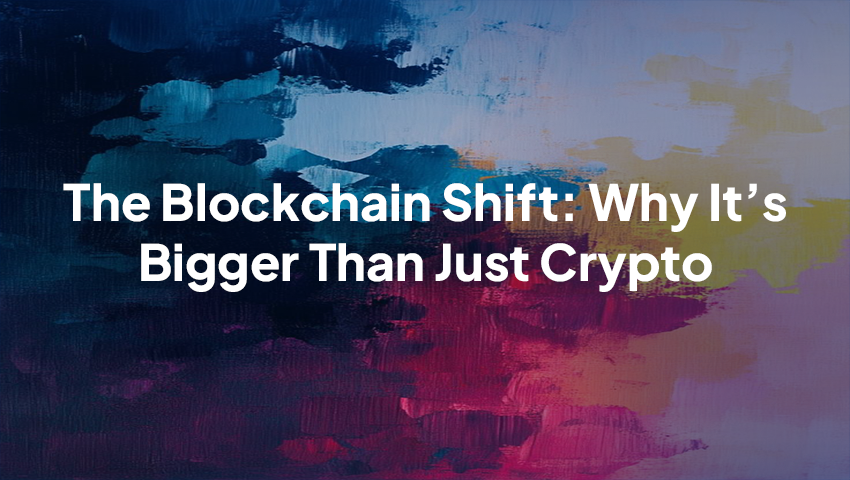The Blockchain Shift: Why It’s Bigger Than Just Crypto
A few years ago, if someone brought up blockchain, chances are they meant Bitcoin. Fast-forward to today, and blockchain technology has moved far beyond crypto—it’s reshaping how businesses build, scale, and secure digital systems.
From blockchain wallets to enterprise-grade apps, the tech is no longer a buzzword. It’s infrastructure.
So… what actually is blockchain?
Short version: the blockchain is a secure, shared ledger that records transactions across a decentralized network. No single party controls it, which means better transparency, stronger security, and fewer middlemen.
It helps you answer:
- How does the blockchain work to verify a transaction?
- Can we track blockchain transactions, down to the blockchain transaction ID and blockchain wallet address?
- What’s an example of a blockchain or a typical blockchain architecture?
If you’re wondering “what is a blockchain in cryptocurrency” or “what is blockchain and cryptocurrency,” think of it as the underlying rails that make digital assets possible.
Why businesses should care
Real problems, real solutions:
- Payments & banking: Faster, cheaper rails for blockchain payment processing and blockchain payments, with growing pilots in blockchain in banking and fintech.
- Healthcare & supply chain: Verifiable data sharing—serious momentum around blockchain technology in healthcare and provenance tracking.
- Gaming & NFTs: Studios and a blockchain game development company can build true digital ownership for assets, from NFT blockchain items to interoperable economies.
- Security: Better data integrity with blockchain and security best practices—especially for industries that need audit trails.
- Tokenization: Assets—from invoices to real estate—are moving on-chain via blockchain tokenization (aka tokenization blockchain).
- Exploration & visibility: Teams look up blockchain activity with scanners and explorers, confirm status via blockchain explorer confirmed transactions, and track flows using blockchain scan tools.
And yes, enterprises are experimenting with blockchain as a service, while modern stacks span layer 1 blockchains like Tron (blockchain Tron), Near, Polygon, Sui, and Avalanche—each tuned for different throughput, fees, and UX.
Where AI meets blockchain
Call it AI blockchain or blockchain AI—the overlap is getting real. AI models need trusted data and provenance; blockchains provide verifiable logs, access controls, and public blockchain auditability. Expect more applications of blockchain tied to AI governance, model licensing, and on-chain attribution.
Talent & upskilling in the US
If you’re eyeing a career pivot, jobs in blockchain are rising—from engineers to product and GTM. Ways to start:
- Learn blockchain fundamentals through courses in blockchain, a blockchain development course, or a blockchain certification course.
- Level up with a certified blockchain professional, certified blockchain developer, or blockchain developer certification—useful signals for hiring managers.
- Build portfolio blockchain projects and practice blockchain programming—spin up a blockchain app wallet / blockchain wallet app, integrate an explorer, or prototype payments.
- Companies frequently post for blockchain developers for hire; founders can hire a blockchain developer or hire blockchain developer teams via a blockchain development agency.
Choosing the right partner
For founders and product leaders, a strong blockchain development company in USA (or a custom blockchain development company) can accelerate delivery—architecture, audits, and shipping. Shortlist top blockchain development companies or a specialized blockchain development agency for your domain. If you need broader help, search blockchain development service or blockchain for development to match scope and budget.
Investors’ corner
You don’t need to be a day trader to explore how to invest in blockchain. Beyond tokens, there are blockchain ETFs, technology stocks, and sector plays (best blockchain stocks, stocks with blockchain technology, and broader blockchain technology stocks). Keep an eye on blockchain price cycles, the overall blockchain market, and regulated access via a blockchain exchange. (Do your own research, of course.)
Getting hands-on (quick guide)
- Set up a wallet: Explore trusted wallet blockchain options; learn the basics of a blockchain address and transaction ID.
- Track transactions: Use explorers to track blockchain transaction history; look up blockchain confirmations; verify the blockchain state.
- Ship a pilot: If you’re developing a blockchain solution or wondering how to create a blockchain, start small: payments, identity, or an example of a blockchain use case within your workflow.
- Level up: Take courses for blockchain, join a blockchain conference / blockchain conferences, follow top blockchain companies and blockchain technology companies for trends.
- Scale: When it works, formalize with a blockchain development company—from architecture and compliance to launch and support.
FAQs (the things people actually ask)
- What’s blockchain? / What’s a blockchain?
A decentralized, tamper-resistant ledger. In short: blockchain is a ledger you can trust. - What is a cryptocurrency blockchain?
It’s the network that records crypto transfers and balances. - How does the blockchain work?
Transactions are batched into blocks, validated by the network, and linked cryptographically. - Which networks should I explore first?
Start with mainstream layer 1 blockchains—Polygon, Sui, Avalanche, Near, and Tron—then decide based on fees, tooling, and user base. - Marketing teams:
Yes, there’s blockchain and marketing potential—proof-of-attendance, loyalty tokenization, and first-party data. (Some even search “que es el blockchain”—global interest is rising.)
Final thoughts
This isn’t “future tech” anymore. Blockchain technology is becoming the backbone of digital business—from finance to healthcare, from games to data platforms. Whether you’re exploring blockchain investment/blockchain investments, building with a blockchain development company, or launching a prototype blockchain business, the best time to start was yesterday. The next best time is now.
Your move: Are you shipping a blockchain app, hiring a team, or heading to a blockchain conference? If you need a shortlist of top blockchain companies or guidance on the right stack (from public blockchain to tokenization), drop a comment—I’ll point you in the right direction.
